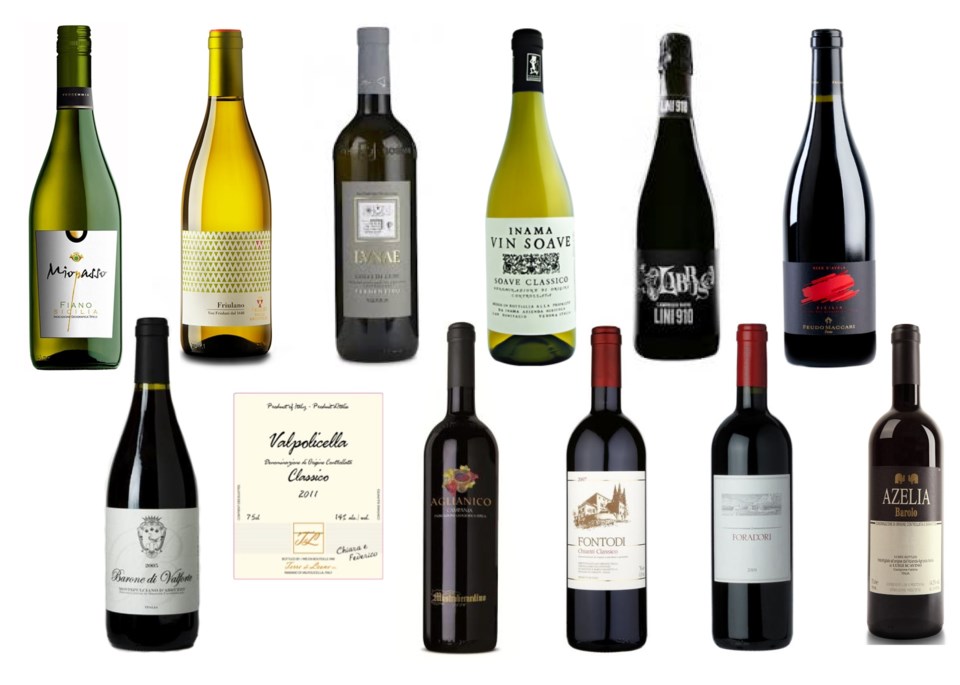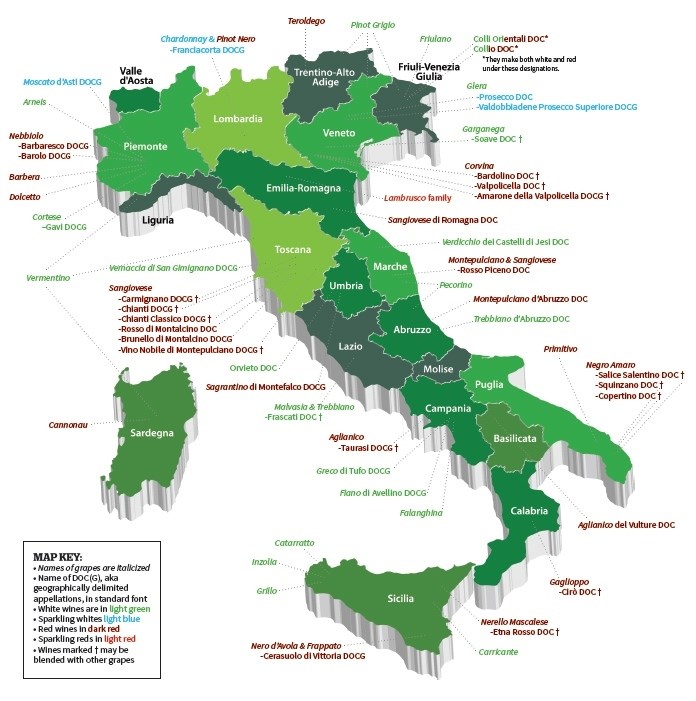I’ll be honest – for me, Italian wine wasn’t love at first sip. It took a while to wrap my palate around these mysterious elixirs. Now, however, I couldn’t imagine my life without them.
Italy can be confusing, frustrating and even aggravating… if you choose to feel that way. I prefer “infinitely fascinating”. It’s impossible to simplify this beautifully complex country and its wines. As such, this isn’t a definitive guide, rather a curated starting point that will hopefully encourage you to immerse yourself deeper.
Simply put, Italy is blessed. Surrounded by the Alps in the north, along with the Apennines forming a mountainous spine from top to bottom, it possesses plenty of hilly sites of varying altitude, exposures and soil types that lend themselves to quality wine production. While the weather becomes more reliable the further south you go, it’s suitable enough throughout to make top-notch wine in every region. A quality revolution in the last three decades has capitalized on these natural advantages and the wine has improved immensely.
Beyond its advantageous geography and climate, Italy’s unique strength is its wealth of indigenous varieties. These are grapes that were born and remained in a specific place for many centuries. At last count, 544 different varieties have been genetically identified and about the same amount have yet to be. That makes well over 1000. Sound daunting? I say intriguing.
To complicate matters further, Italy labels its wines by the area from which they hail. In some cases the grape is incorporated into the name, such as Montepulciano d’Abruzzo DOC. In many, it isn’t. Take Barolo DOCG for example. Barolo is the name of a town. The wine is always made exclusively from the Nebbiolo grape though this won’t appear anywhere on the label.
A country of fairly recent union (1861), Italy boasts 20 very distinct regions, and each has preserved a unique culture where food and wine are so intimately intertwined with its identity. As you may well imagine, they all offer their own local specialties and the wines from one region are very different from the next.
If I were to make one generalization about Italian wines, it’s that they’re made to go with food. They are often better with a meal than on their own. They can be assertively structured, meaning firm tannins that dry your mouth as well as an elevated acidity that simultaneously makes it water. This, along with an innate savouriness serves to stimulate the appetite brilliantly.
Italian wine offers such diversity that it’s impossible to become bored. Yet it’s equally challenging to know them all. I say just give yourself over to the adventure. The best approach is to taste your way through Italy one wine at a time. Be prepared for life long discovery.

12 wines that will transport you to Italy
I’m going to make the bold assumption that you already have your favourite Pinot Grigio and Prosecco. I feel it is my duty to encourage you to drink beyond these.
Here are 12 wines made from some of Italy’s finest indigenous grapes to get you started. Prices are exclusive of taxes.
White
2012 Miopasso, Fiano, Terre Siciliane IGT $16.59
Fiano’s success in Campania has led this grape to travel beyond its birthplace. This characterful and affordable version from Sicily displays lime blossom, honey and waxy herbs with a touch of nuttiness and juicy guava. A rich white deserving of halibut and buttery potatoes.
2013 Tenuta di Angoris, ‘Villa Locatelli’ Friulano, Isonzo del Friuli DOC $17.69
Friulano is Friuli-Venezia Giulia’s flagship grape. Sporting subtle aromas of lemon balm, grass, citrus and green apple, it’s delightful when nibbling cheese and charcuterie.
2013 Cantine Lunae, Vermentino, Colli di Luni DOC $23.49
The Colli di Luni DOC straddles the coastal hillsides of Liguria and Tuscany. Vermentino is an important grape in this corner of Italy. Pink grapefruit peel, apricot and thyme flowers are balanced by a creamy texture and refreshing tang that make it fit for fish and chips.
2012 Inama, Soave Classico DOC $26.29
Extension beyond superior hillside slopes to less suitable surrounding plains and high yields have conspired to tarnished Soave’s reputation. Inama is here to win you back. Unoaked and made from 100 per cent Garganega, it captivates with almond blossom, camomile, lavender and a chalky minerality. The perfect foil for pesto sauce.
Sparkling
n/v Lini 910 ‘Labrusca’ Lambrusco Rosso Reggiano DOC $17.39
A specialty of Emilia-Romagna, Lambrusco comes in varying shades of red and a range of sweetness. It’s requisite bubbles play the laudable role of helping digest the region’s hearty cuisine. “Lambrusco”is actually a family of mostly related grapes and the Lini 910 features Lambrusco Salamino. Exuberantly fruity yet dry and finishing with mouth scrubbing tannin, it’s must with BBQ ribs.
Red
2013 Feudo Maccari, Nero d’Avola, Terre Siciliane IGT $17.69
Sicily’s most widely planted red grape, Nero d’Avola allies fruitiness with structure and savouriness. Here rosemary and sweet tobacco meet dark cherry and a touch of prune. Delicious with Moroccan-style lamb.
2012 Barone di Valforte, Montepulciano d’Abruzzo DOP, Italy $17.96
A great example of the deeply coloured, substantially tannic Montepulciano grape. Robust and friendly with luscious flavours of black plum and sweet spice, it’s fantastic with pizza.
2012 Terre di Leone, ‘Chiara e Federico’ Valpolicella Classico DOC $27-30*
The wines of Valpolicella are blends based on the Corvina grape. Terre di Leone’s higher altitude site and volcanic soils impart freshness and elegance. This medium weight red offers black pepper, smoky spice and red plum. Try with grilled pork chops.
2011 Mastroberardino, Aglianico, Campania IGT $30-33*
Aglianico can be brutally tannic with rapier-like acid in its youth but it has the genes to age gracefully. Here’s a slightly softer, more approachable introduction. Savoury and earthy with dark fruit offset by scented floral and mineral notes, it’s a treat with gamey sausages.
2011 Fontodi, Chianti Classico DOCG $31.79
Italy’s most planted grape, Sangiovese is equally responsible for the simplest of wines as well as some of the most complex and ageworthy bottles (think Brunello and Chianti Classico). This seriously classy wine possesses tell-tale tea, violet and red cherry notes backed up by firm tannin. Bring on the steak.
2011 Foradori, Teroldego, Vigneti delle Dolomiti IGT, Italy $36.99
For long, Trentino’s local Teroldego grape was relegated to a colour booster for Italy’s paler reds. Elisabetta Foradori demonstrates its true potential. Juicy and concentrated with black cherry, herb, licorice, tar and ripe tannin, it would make a fine match with bison burgers.
2010 Azelia, Barolo DOCG $49.26
Ah Nebbiolo… The stunning grape behind Piemonte’s Barolo and Barbaresco DOCGs. Truly haunting aromas of rose, dried raspberry, wild strawberry and cedar. Refined and silky with Nebbiolo’s signature tannic grip. A great value collectable wine that could do with a few years in the cellar. Buy it while you can!
*Private wine stores only. All other wines available at BC Liquor Stores.
A note on Italian wine labels:
Denominazione di Origine Controllata/Protetta (DOC/P): Geographically defined zones with their own regulations including which grape varieties are permitted. There are well over 300 DOCs.
Denominazione di Origine Controllata e Garantita DOCG: A top-tier of the above that includes some of Italy’s most highly regarded wines like Barolo, Barbaresco, Brunello and Amarone della Valpolicella. Seventy-three DOCGs in total.
IGT/P Indicazione Geografica Tipica/Protetta: A broader geographical indication offering flexibility in terms of permitted grapes.
Classico: The original production zone of a particular wine. It is often hillier and subsequently superior.
Riserva: Aged longer than its non-riserva counterpart. It also has to have a higher minimum alcohol level. Caveat: it doesn’t necessary mean a better wine.
• Michaela Morris is one of 26 Italian Wine Ambassadors certified through the prestigious Vinitaly International Academy and received the top mark among candidates from around the world. She has been lecturing on Italy for the Wine & Spirit Education Trust Diploma programme since 2007. Michaela travels to Italy frequently throughout the year to taste the latest releases, attend lectures, speak at conferences and lead wine tours. You can follow her Italian wine adventures and recommendations on Twitter and Instagram @MichaelaWine.




